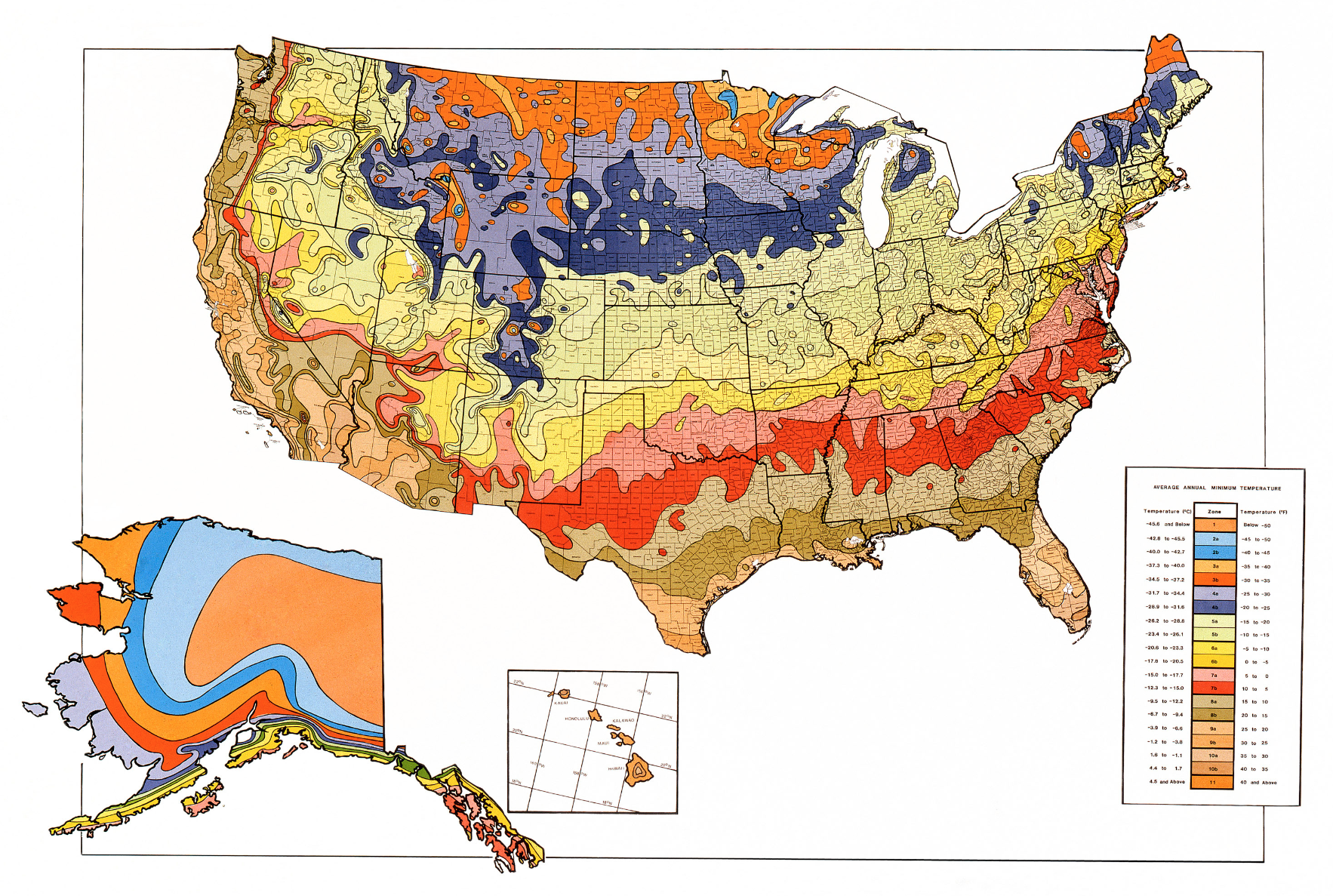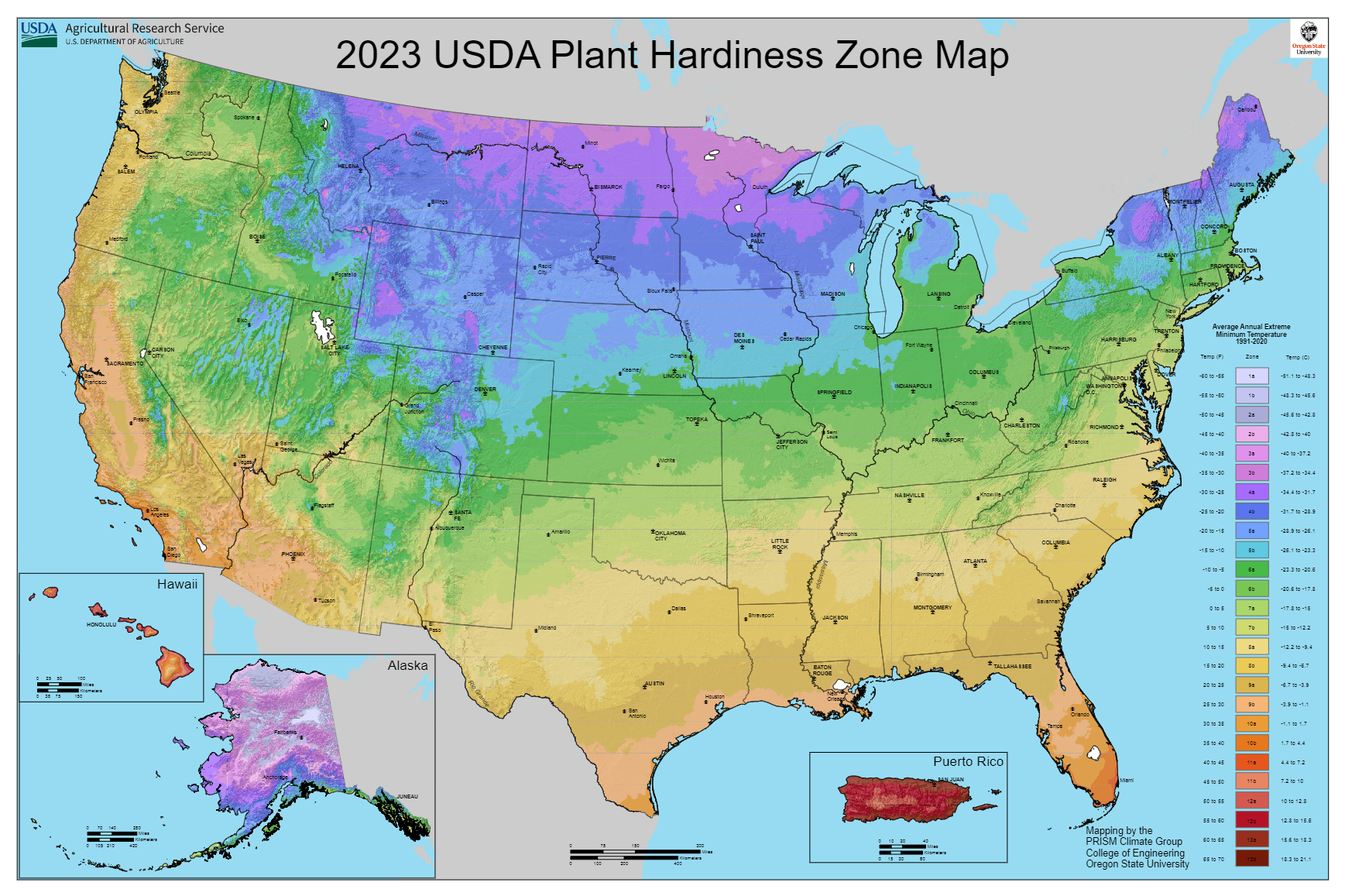Understanding the Updated 2023 USDA Hardiness Zone Map
By Ryan Dorn, SouthernSeeds.com
In the dynamic world of gardening, adaptability is not just a virtue; it's a necessity. This truth is underscored by the recent release of the 2023 USDA Plant Hardiness Zone Map, the first significant update in over a decade. This new map is a clear reflection of the shifts in climate we're experiencing globally, a phenomenon that deeply resonates with both gardeners and farmers. These changes are not just academic; they symbolize the tangible environmental transformations happening around us.
As you delve into the nuances of this updated map, you may discover that your local gardening zone now falls into a warmer category. This change is far more than a mere adjustment in numbers; it's a vivid indicator of our changing times. Rising temperatures are reshaping our landscapes, influencing both the way we garden and the varieties of plants that thrive. Regardless of individual beliefs about climate change, its effects on the gardening world are undeniable and demand our attention and adaptation.
This latest revision of the hardiness zone map isn't just about recalibration; it's an invitation to embrace new challenges and opportunities in gardening. It's an opening to experiment with plant varieties that, until now, may not have been viable options for your area. Gardening, much like life, is about sowing ideas and nurturing their growth. While this post isn't intended to guide you on how to use these maps – for that, you can refer to our detailed blog post on Navigating the Gardening World Through USDA Hardiness Zones – our goal here is to spotlight the significant changes in the latest map. So, let's take a closer look and understand what these changes mean for our future in gardening.
Evolution of USDA Hardiness Zone Maps
Navigating the world of gardening and farming in our ever-changing climate, it's intriguing to step back and trace the evolution of the USDA Plant Hardiness Zone Maps. This look back gives us a clear picture of our environment's transformation and helps us grasp the changes over time. Join me as we take a stroll through the hardiness zone maps of 1990, 2012, and the recently updated 2023 edition.

1990 Map: This edition served as a fundamental guide for gardeners and farmers for over two decades. Based on the climate data available at the time, it outlined the zones where various plants were most likely to thrive.

2012 Update: The 2012 map was a significant update from the 1990 version, incorporating more sophisticated climate data and technology. It showed noticeable shifts in plant hardiness zones, reflecting the gradual warming trends and environmental changes occurring over that period.

2023 Revision: The latest map brings us to the present, integrating the most recent climate data and showing even more pronounced shifts towards warmer zones across the United States. This version underscores the rapid pace of climatic changes in recent years.
While comparing these maps side by side is fascinating, it's not always easy to spot the differences at a glance. Yet, the changes are undeniable and continue to profoundly affect our growing seasons and the types of plants that will flourish in our regions. These maps aren't just tools; they're a reminder of the dynamic nature of our environment and the need to adapt our gardening strategies accordingly.
Notable Changes in the 2023 USDA Hardiness Zone Map
The 2023 USDA Hardiness Zone Map elucidates significant warming trends, particularly in the Northeast and Midwest, which have experienced the largest shifts. These regions, historically known for their defined seasons and cold winters, have seen a notable nudge into warmer zones. This transition is impactful, altering the fabric of long-established planting traditions and challenging the status quo of agricultural practices.

In the Northeast, gardeners who have cultivated the same crops for generations are now observing that their local zones can accommodate a new variety of plants that were once impossible to grow in these cooler climates. The Midwest, too, has warmed, with implications that extend beyond garden boundaries. Farmers in these areas are adjusting to earlier planting dates and exploring the potential for crops that previously could only be grown in more southerly locations.
These changes are indicative of a broader trend of rising temperatures and reflect the dynamic nature of our environment. As such, the new map provides a crucial reference point for understanding how climate change is reshaping our ecosystems. The shifting zones in these particular regions of the United States underscore the reality of a warming world, and they serve as a benchmark for gardeners and growers to adapt their strategies for the seasons ahead.
Implications for Gardeners and Growers
What does this mean for you, the dedicated gardener or the enterprising grower? The updated USDA Hardiness Zone Map necessitates a thoughtful reassessment of the plants you're accustomed to growing. Take blueberries, for example. These beloved berry bushes have specific 'chill hour' requirements—periods of cold necessary for them to set fruit. In areas that previously provided the perfect chill conditions for varieties like the Northern Highbush, growers are now facing challenges. Warmer winters mean fewer chill hours, leading to disappointing yields.
As these regions warm, gardeners must adapt by turning to varieties like the Southern Highbush Blueberry, which thrives with fewer chill hours. This shift not only ensures the continuation of blueberry cultivation, but also opens doors to growing these delightful and less demanding berries in areas previously thought too warm for blueberry production.

Yet, while some changes bring new opportunities, they also usher in new challenges. Warmer zones can encourage the spread of invasive species and pests that were previously kept in check by cold temperatures. This shift could disrupt local ecosystems and existing agricultural practices.
For the gardener, this evolution in zones means staying informed and flexible. It involves selecting plant varieties that will succeed in your garden's current climate while keeping an eye on the environmental impact. As we adapt to these changes, our gardens become living laboratories, spaces where we can learn, experiment, and grow alongside the shifting climate.
Looking Ahead with Optimism
As we navigate these shifts in climate and hardiness zones, it's vital to remember that change isn't inherently negative. Gardening has always been about working in tandem with nature’s rhythms, and these changes are simply a new verse in the age-old gardening story. While significant, they offer unique opportunities for growth and adaptation. In regions experiencing warming, gardeners might find the chance to expand their harvests. Consider the example of northern farmers: traditionally limited to two harvests per year, they might now experience conditions conducive to a third, much like their counterparts in warmer climates.
In places like Florida, the warm climate allows for a more diverse planting schedule. Gardeners there have the opportunity to grow cool-weather crops like Bloomsdale Spinach after the summer heat, followed by an early spring rotation, and then transition to heat-loving varieties like Malabar Spinach or New Zealand Spinach during the warmer months. This exemplifies the benefits of adapting to your environment – it's about making the most of the current conditions while also preparing for an uncertain future.
Kim Todd's, a professor and extension landscape specialist, reminds us that shifts in climate are not new. Embracing our role as stewards of the earth, we can see these changes as an opportunity to explore, innovate, and thrive in our gardens. Whether it's maximizing harvests in a newly warmed climate or adjusting planting strategies to suit evolving conditions, the key to success lies in our ability to adapt. As gardeners, we are the resilient protagonists in this ongoing narrative, learning and growing alongside our environment, ensuring our gardens remain spaces of beauty, bounty, and biodiversity, regardless of what the future holds.
Wrapping Things Up!
The updated USDA Hardiness Zone Map is more than a tool; it's a testament to our planet's ever evolving conditions and our ability to adapt. While the shift towards warmer zones may pose new challenges, it also offers a chance to expand our horticultural horizons. As gardeners, we are guardians of an ever-changing landscape, tasked with the joyous responsibility to tend, toil, and transform alongside the earth.
In navigating these new zones, we're invited to embrace a spirit of innovation, exploring a wider palette of plants and gardening techniques. It's an opportunity to deepen our understanding of the natural world and to engage with our local gardening communities for insights and advice. Above all, it's a call to action for all of us to become more attentive and responsive to the environment we are intrinsically a part of.
So let's look forward with optimism and a readiness to learn. The changing map doesn't signal an end to our cherished pastime, but rather marks a new chapter in our gardening journey—a chapter where adaptability and sustainability are the central themes. With each seed we sow, we acknowledge the shifts in our climate and commit to being the best stewards we can be. Together, we'll continue to cultivate not just our gardens, but a legacy of stewardship for generations to come.
And remember... if you ever need any help in your gardening journey, we are always here to help!

